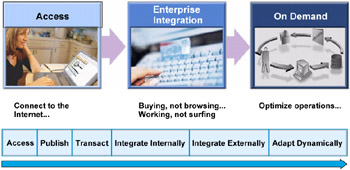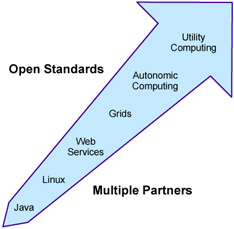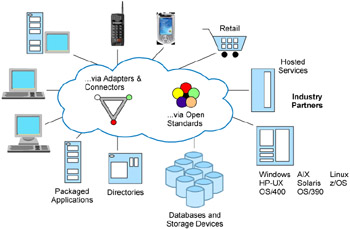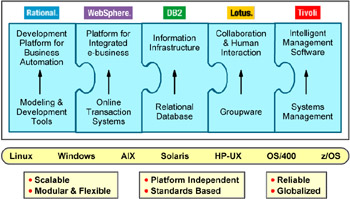A.1 e-business on demand: A developer s roadmap
|
| < Day Day Up > |
|
A.1 e-business on demand: A developer's roadmap
| Note | This article is by Alfredo Gutierrez—Manager, IBM developerWorks® Developer Skills Program (February 17, 2003).IBMers can find this article at http://www-106.ibm.com/developerworks/ibm/library/i-ebodov/. |
What is it all about, and what does it mean to you?
IBM has defined e-business on demand as an enterprise whose business processes—integrated end-to-end across the company and with key partners, suppliers, and customers—can respond with speed to any customer demand, market opportunity, or external threat. Are you wondering just what this means for you? Developers and IT professionals will be expected to build the technical infrastructure to support the integrated business processes of e-business on demand. To help you get up to speed, this article describes the e-business on demand environment and gives you the technology roadmap to get there.
It's all about return on investment. In the beginning, the Internet linked scientists in academia, government, and research. It evolved to provide e-mail and then the World Wide Web, which was good for communicating market messages but didn't have a lot of business value. Technology quickly evolved and enabled computing on the Internet, driving business processes. But this capability has come with a cost—it has required serious investment in technology. And when a business invests in information technology, it expects to derive benefits from its investment. Issues of cost reduction never go away.
So what's the problem?
There's a gap between what IT promises and what it delivers. You're a developer—you know that integrating disparate, heterogeneous systems and networks is complex. This complexity is the number one issue troubling CIOs today. Just trying to get technologies to work together eats up more than 40 percent of IT budgets. That means almost half the IT investment goes toward things that don't directly drive business value. Because it's complex, it can take months, maybe a year, before an IT investment delivers any value. Because it's complex, skills are in short supply, and it will get harder to hire the people to integrate, implement, and maintain technologies. Complexity costs.
And then there's utilization costs. Did you know that:
-
Mainframes are idle 40% of the time.
-
UNIX servers are idle 90% of the time.
-
Most PCs are idle 95% of the time.
Of course, the industry grappled with cost of ownership and utilization long before the Internet and e-business introduced a new era of computing. Now we have the Web, but the promise of complete business integration efficiency still lies in the next generation of e-business technology infrastructure. And this is where you—the developer—come into play.
In this article, we'll take a tour of the e-business on demand environment and look at what businesses are demanding from a technology infrastructure. Then we'll talk about how you can integrate heterogeneous systems and platforms using a roadmap that incorporates these technology milestones:
-
Java and open standards
-
Linux
-
Web services
-
Grid computing
-
Autonomic computing
-
Utility computing
Just what is e-business on demand?
You are in an e-business on demand environment when your organization connects its core business systems to key constituencies using intranets, extranets, and the Web, allowing you to:
-
Build and enhance business relationships through the thoughtful use of network-based technologies
-
Leverage Internet technologies to transact and interact with customers, suppliers, partners, and employees to achieve and sustain a competitive advantage
Getting to e-business on demand is a natural progression that typically goes through these stages:
-
Access— Enable transactions against core business systems using simple Web publishing and point solutions.
-
Enterprise integration— Use the Web to integrate business processes across enterprises. Link internal and external systems, both across enterprises and beyond enterprise boundaries.
-
e-business on demand— Use the Web to adapt dynamically to customer and market requirements. Change business models. Combine people, technologies, and processes in new ways.

Figure A-1: A natural evolution
Phases of e-business on demand
e-business on demand evolves in phases. In each phase, the Internet transforms the business processes.
-
Access to digital information—This phase is all about publishing content, most of it of the static "look-up" variety. Simple database queries allow us to check a bank account, look up airline flight information, or see where our overnight package is. It's pretty easy to get in the game here. All an enterprise needs is a home page. All an individual needs is a browser.
-
Real transactions, real e-business—Don't just look at your bank account—move some money. Don't just check a flight departure time—book your seat. Trade a stock, buy a book, apply for a loan, renew your driver's license, take a college course. Doing this requires more than a Web site—this requires behind-the-scenes integration of technologies and business processes.
-
The advanced stage of e-business—In a fluid system of customers, suppliers, partners, and employees, the Internet is the primary way to communicate, transact, and connect. Business processes shift from manual to automated. A relationship could last only as long as a single transaction. The environment is real time computing. You form networked communities so that organizations can:
-
Create new products and services faster
-
Reach new customers and economically add new relationships
-
Dynamically change existing relationships
-
Simultaneously engage in multiple e-business models
-
Improve access to information by constituents involved in these relationships
-
What's the return on investment for an enterprise that progresses through these phases? An increased share of customer spending, a better return on assets, new revenue opportunities, and better shareholder return.
Every industry segment has the common requirement to integrate end-to-end so that products, services (private sector and government), invoices, images, decisions, and answers are all available on demand. Who will have the competitive advantage? The enterprises that get there first, and the software and services providers that know how to make it happen.
Any globally connected enterprise must have the ability to handle whatever comes its way, such as changes in customer preferences or competitive actions, fluctuations in capital markets, labor situations, natural disasters, or political unrest. An advanced e-business must be able to respond to the unpredictable and the unforeseen and never question the ability of the infrastructure to deliver.
| Which phase is your enterprise in? | About 75% of all businesses are in Phase 1. Another 20% are in Phase 2 and are already reaping the benefits. These businesses have identified key processes—from procurement of raw material to the manufacturing floor, to shipping and distribution, to customer relationship management—and they're applying networked technologies to transform them. These enterprises have determined that transforming a standalone process is a beginning, not an end. |
So what kind of computing environment is required for an on demand business? What does "on demand" mean for the way a business buys and manages its computing technology? Before tackling these questions, let's look at the four business characteristics of an on demand business:
Business characteristics of an on demand environment
An on demand business has these characteristics:
-
Responsive— Able to sense changes in the environment and to respond dynamically to unpredictable fluctuations in supply or demand, emerging customer, partner, supplier and employee needs, or unexpected moves by the competition.
-
Variable— Able to adapt cost structures and business processes flexibly, to reduce risk, and to drive business performance at higher levels of productivity, cost control, capital efficiency, and financial predictability.
-
Focused— Committed to concentrating on core competencies and differentiating tasks and assets; able to use tightly integrated strategic partners to manage tasks ranging from manufacturing, logistics, and fulfillment to human resources and financial operations.
-
Resilient— Prepared for changes and threats like computer viruses, earthquakes, or sudden spikes in demand.
A business with these attributes requires technology that can support it, but that's not the computing environment that's operating today. No, today's environment is heterogeneous, widely distributed, vertically isolated, and generally more complex than businesses would like. The same IT that's essential to a business's ability to create strategic advantage, is also a major obstacle to becoming the kind of fluid, responsive, dynamic business that's been talked about for years.
Technical characteristics of an on demand environment
Based on the above business characteristics of an on demand business, what kind of technology environment is needed to support it?
It's integrated
Beyond just transformation department by department, business processes and applications need to integrate horizontally to link data, legacy systems, and custom applications, and this integration requires new levels of data integrity and transaction processing. You will need an infrastructure built on Web services, new development tools, and open standards. Applications that had previously integrated vertically—with an operating system and standalone processor—must now integrate horizontally, application to application. You will write applications to the middleware layer, not to the operating system. Applications are being decoupled from the underlying infrastructure.
It's open
There's no other way. In a networked world, you have to do more than simply integrate everything inside your enterprise. You have to connect your enterprise with other enterprises, other business processes, other applications, and billions of pervasive computing devices. You can't just rip and replace your existing data, applications, and transaction systems to make them homogenous with those of your business partners. Open specifications and industry standards are the only realistic way that all of this can connect.
It's virtualized
Every organization that has made capital outlays for technology is sitting on enormous, unused computing capacity. Server consolidation and capacity on demand offerings begin to address the issue of under-utilization. But now there's an opportunity to virtualize the entire data center with an emerging technology called grid computing. Grid computing allows distributed computing resources to be shared and managed as if they were one, large, virtual computer. Initially most grids are being built in government laboratories and universities. From there, they will be implemented inside companies. These "intragrids" will allow enterprises to increase the utilization of their own computing assets.
It's autonomic
The upward spiral of complexity will soon exceed the ability of skilled technical, human resources to keep up with it. The solution? Computing systems that take on more of the management themselves. In the same way that the human autonomic nervous system manages basic functions like respiration, autonomic systems will self-manage, self-protect, balance workloads, install device drivers, and upgrade software. This requires innovation, real science at both the component and overall system level. In 2001, IBM's technical community articulated the capabilities and requirements for this kind of autonomic infrastructure. IBM Research defined the kinds of innovation required at the component, product, and systems levels. The industry has been invited to join us in the mastery of this computing challenge.
Utility computing
We've been discussing transformation on two levels:
-
Transforming business processes
-
Transforming the underlying technical infrastructure
Together, these transformations bring yet another transformation that may prove to be the most exciting aspect of the movement to e-business on demand: the way a business buys and manages its computing power.
Until now, your choices were limited. You needed more computing power? You bought more computers, or you outsourced. Now, on demand business requires a fundamental change in the way we access, pay for, and manage all the assets of the IT industry.
The answer is utility computing. You virtualize the data center and build internal computing utilities that drive up utilization and value delivered to the business. When this kind of virtualization moves to the Internet, you'll be able to tap into external utilities, get computing from service providers, and pay only for what you use.
Technology roadmap
If adaptive, dynamic integration is the goal, and utility computing is how you're going to implement it, where do you start? Focus on the key technologies: open standards and Java, Linux, Web services, grid computing, and autonomic computing.

Figure A-2: Landmarks on the technology roadmap
Open standards and Java
You don't want to rip and replace. Instead, you want to link together your disparate, distributed, heterogeneous systems, and you can do this using open standards. You can use open standards to ease your integration burden and tie new products and technologies into your existing infrastructure easily and at low cost.
In your on demand environment, you must be able to add or reduce capacity quickly as the business requires. In today's heterogeneous environment, open standards with common interfaces let you choose function from a variety of vendors and snap it into the infrastructure. The IT industry is evolving into a culture of open standards.

Figure A-3: Open standards speed integration
Linux
Why choose Linux? First, it's reliable, scalable, and secure. It's an enterprise-quality operating system, and you can trust Linux with your enterprise applications because it's a stable and mature base.
Second, Linux is about the lowest-cost alternative on the market, and that's a major factor in its growing appeal to business and government. It's easy to migrate your code from UNIX to Linux, and there's a sizeable pool of developers with Linux skills.
Plus, the applications you write for Linux can run on any platform. You can choose the server that's right for the application instead of the application that's right for the server. This flexibility frees you to innovate and create new applications, rather than spending your time rewriting old ones.
Finally, Linux provides an open, standards-based application platform, especially when combined with J2EE and Web services. Open standards make sense because they allow you to choose the best from among a wide variety of products and integrate them easily, rather than having to settle for whatever fits into a proprietary environment. This is a new model for the industry—companies compete to produce the best products on this open standards base, instead of competing to establish a proprietary hold in a particular industrial segment.
| Linux and the IBM eServer™ products: | For IBM, Linux is consistent with our principles of open standards-based computing and platform independence. We have solutions for Linux across all our hardware platforms, and our middleware provides extensive support for Linux across the entire eServer set of platforms. |

Figure A-4: Comprehensive Linux support in IBM software
Web services
Businesses have been searching for a technology solution to enable their infrastructures to be as flexible as their highly fluid business models. They've found an answer in Web services architecture, a set of industry standard methods that enable simplified programmatic connections between applications. Web services focuses on simple, Internet-based standards to address heterogeneous distributed computing.
Applications designed within a Web services architecture can seek each other out, integrate and execute transactions, all in an automated fashion. The advantages for a business are clear. A manufacturer could automatically connect with the supplier that best meets its cost and technical demands, while that supplier in turn could connect automatically with manufacturers that have similar needs.
| Web services and IBM software: | IBM has enabled its software portfolio (from WebSphere to DB2, Lotus, and Tivoli) to support the development, deployment, storage, and management of Web services solutions. |
Grid computing
A grid is a collection of distributed computing resources available over a network that appear to an end user or application as one large virtual computing system. A grid can span locations, organizations, machine architectures, and software boundaries to provide unlimited power, collaboration, and information access to everyone connected to the grid. The effect of grid computing is to make network computing more like a utility. You deliver computing power to where you need it only when you need it; you pay for what you use, when you use it.
Like the Internet, grids started in the scientific community but are now being deployed by business enterprises. Recently, IBM and Globus collaborated to combine open grid protocols and Web services standards, producing the Open Grid Services Architecture (OGSA).
Autonomic computing
Autonomic computing systems are:
-
Self-configuring— Able to adapt to dynamically changing environments
-
Self-healing— Able to discover, diagnose, and act to prevent disruptions
-
Self-optimizing— Able to tune resources and balance workloads to maximize use of IT resources
-
Self-protecting— Able to anticipate, detect, identify, and protect against attacks
When you implement autonomic systems, you are free to focus on more strategic and higher-level issues. For the business, the core benefits of autonomic computing are improved resiliency, ability to deploy new capabilities more rapidly, and increased return from IT investments.
Autonomic computing capabilities play a critical role in the development of grid computing. Grids can become the most complex computing environments available. Autonomic computing will allow grids to be easily managed and to ensure that they deliver the levels and quality of service demanded by businesses.
Utility computing
The concept of e-sourcing is simple. It's Information Technology as a utility. Think of electricity, or telephone service. You don't need a generator to get electricity to your home or office. You just plug into the electrical grid, use what you need, and pay for what you use. An enterprise will be able to focus maximum resources on its core business, on what differentiates them from their competition.
Where's the data center? It's in the enterprise. It's outside the enterprise. Or it's shared between them. It doesn't matter where, because the infrastructure becomes a pool of resources available on demand. Like electricity, computing becomes an on demand, pay-as-you-go service—a utility so reliable that a business can take it more or less for granted.
Once grids enable computing resources to be shared globally and managed autonomically from end-to-end, an enterprise's infrastructure becomes incredibly flexible. It can deliver computing power itself, but also switch to a supplier for peak power, since they both operate on the same standards. The infrastructure is a pool of virtual resources a customer can call on as needed.
In an on demand future, a company might respond to increasing demand for computing resources first with spillover services from their own IT utility and, if that isn't enough, with capacity from a service provider, purchasing only the extra capacity needed at the moment. Because provider and customer share common, open protocols and use grid and autonomic technologies, all sorts of services can be provided dynamically in the smallest, most economical blocks. Imagine paying for increments of computing power as used instead of for large volumes, long term. The potential impact on budgets and the bottom line is huge.
The concept of IT delivered as a utility isn't new; but only now are technological advances making it possible:
-
Reduced cost of bandwidth, which enabled the creation of new data services and high-speed network delivery of a variety of services to a broader range of customers
-
Distributed content and application architecture deployments that shift delivery to the edge of the network
-
Server and storage virtualization, which enables a new level of shared infrastructures with the potential of reducing customer costs
Over time, as the focus turns more toward the application and the business rather than the infrastructure, the question will become: "Do I really need all that infrastructure?" To put it another way, "Do I want to generate my own electricity, with all the investment in people and equipment that entails? Or am I comfortable leaving the generation of electricity to the experts and IT to the IT professionals?"
Conclusion
Add them all together: You have applications and systems integrated using open standards. Plus Web services that provide definitions, discovery, and access to self-managing, autonomic IT resources on a grid. And what do you get? You get computing resources capable of being shared globally and managed end-to-end. You get an infrastructure that's incredibly flexible and that will allow new capabilities to be deployed with relative ease. This is the technical environment on which an on demand enterprise depends.
With e-business on demand, information technology will change. IT will be delivered as a utility. Utility computing will offer fundamental advantages over the current model. You'll get there in stages, and you can start today by following the technology milestones we've outlined: Java and open standards, Linux, Web services, grid computing, and autonomic computing.
|
| < Day Day Up > |
|
EAN: 2147483647
Pages: 82